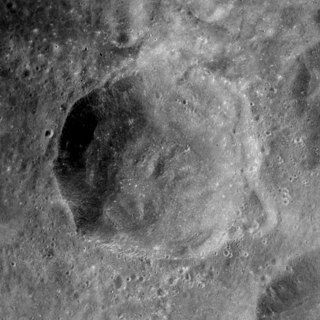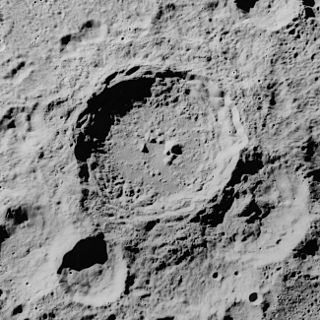
Chamberlin is a lunar impact crater that is located on the far side of the Moon, just past the southeastern limb. It lies to the southeast of the crater Jeans, and Moulton is attached to the southeastern rim of Chamberlin. This crater is located in a part of the lunar surface that has undergone resurfacing of crater interiors, producing dark-hued crater floors.

Desargues is an ancient lunar impact crater that is located near the northern limb of the Moon, on the western hemisphere. It lies nearly due south of the crater Pascal, and southeast of Brianchon. The proximity of this crater to the limb means that it appears highly elongated due to foreshortening, and it is difficult to discern details from the Earth.

Cepheus is a lunar impact crater that is located in the northeastern part of the Moon, within one crater diameter of the larger crater Franklin to the southeast. To the north-north-east is the flooded crater Oersted. The proximity of this formation to the lunar limb means it appears oblong when viewed from the Earth due to foreshortening.

Barringer is a lunar impact crater that is located on the southern hemisphere on the Far side of the Moon, named after geologist Daniel Barringer. It is attached to the north-northeastern rim of the walled basin named Apollo, and lies to the southeast of Plummer. South of Barringer, on the floor of the Apollo basin, is the crater Scobee.

Baldet is a lunar impact crater that is located on the southern hemisphere on the far side of the Moon. It lies in the lava-flooded region between the craters Cori to the north, Stoney to the southwest, and the worn walled plain Minkowski to the southeast.

Blazhko is a lunar impact crater that is located in the northern hemisphere on the far side of the Moon. It lies to the northwest of the crater Joule, and to the south of Gadomski. The fresh, bright crater Wargo is to the south.

Brunner is a lunar impact crater that is located along the eastern limb of the Moon, to the southeast of the Mare Smythii. At this location the crater is viewed from the edge, and so it is not possible to see much detail from the Earth. The visibility of this formation is also affected by libration. The crater lies to the southwest of the walled plain Hirayama, and to the east of the elongated crater Houtermans.

Bronk is an eroded crater that lies on the far side of the Moon, out of sight from the Earth. It lies to the southeast of the larger crater Kovalevskaya. Less than one crater diameter to the east-northeast is the smaller crater Bobone.

Cusanus is a lunar impact crater that is located near the northeastern limb of the Moon. In this location the crater appears very foreshortened when observed from the Earth, and its visibility is affected by libration. The northern rim of Cusanus is nearly joined to the south-southeastern rim of the larger crater Petermann. To the west is Baillaud and to the southeast is Hayn.

Haidinger is a lunar impact crater that is located in the southwestern part of the Moon. It was named after Austrian geologist Wilhelm von Haidinger. Just to the southwest of the crater is the small lunar mare named Lacus Timoris. Haidinger lies northwest of the crater Wilhelm and east of the irregular formation Hainzel.

Chebyshev is a large lunar impact crater that lies in the southern hemisphere on the far side of the Moon. The somewhat smaller crater Langmuir is intruding into the east-southeastern rim of Chebyshev, forming a chain of large craters with Brouwer on Langmuir's eastern rim.

Schwarzschild is a large lunar impact crater, approximately 211 kilometers (131 mi) in diameter. It is located in the northern part of the Moon's far side. The nearest craters of note are Seares to the northeast, and Gamow to the southeast. It was named after German physicist and astronomer Karl Schwarzschild (1873–1916).

Wright is a lunar impact crater that is located near the western limb of the Moon. It lies on the irregular plain between the Montes Cordillera and Montes Rook, two ring-shaped mountain ranges that surround the Mare Orientale. Just to the southeast of the crater is the slightly larger crater Shaler. To the north of Wright is the crater Pettit.

Douglass is a lunar impact crater on the far side of the Moon. It lies to the southwest of the crater Frost and south-southwest of the large walled plain Landau.

Galois is a large lunar impact crater on the far side of the Moon. Features of this class are commonly termed walled plains, due to their appearance and dimension. It is located just to the southeast of another huge walled plain, Korolev, a formation nearly double the diameter of Galois. Several hundred kilometers due south is another enormous feature, Apollo.

Guyot is a lunar impact crater on the Moon's far side. It is separated from the crater Kostinskiy to the northeast by only a few kilometers of rough terrain. To the west-southwest lies the crater Lobachevskiy and to the east-southeast is Ostwald.

Katchalsky is a crater that lies on the far side of the Moon. It was named after scientist Aharon Katzir-Katchalsky. It lies to the southeast of the larger crater Lobachevskiy, and to the west of the prominent King. Less than a half-crater diameter to the southeast of Katchalsky is Viviani.

Langemak is a prominent impact crater on the far side of the Moon. It is located less than one crater diameter west-northwest of Danjon, and nearly due east of Meitner. To the southwest of Langemak is Kondratyuk. Langemak partly overlies the larger and older crater Langemak N. This feature is also attached to the northeastern rim of Kondratyuk.

Olcott is a relatively fresh crater on the far side of the Moon. It was named after American astronomer William Tyler Olcott. It lies to the south-southeast of the craters Seyfert and Polzunov, and to the north of Kostinskiy.

Stein is an elongated impact crater formation that lies just to the east of the larger crater Tiselius, on the far side of the Moon. Farther to the east-southeast of Stein lies Krasovskiy.






















